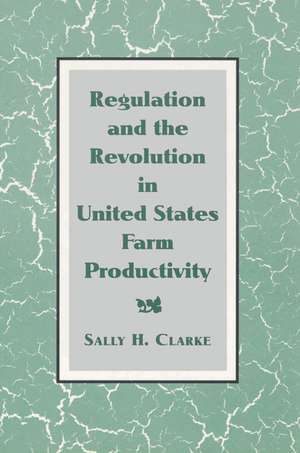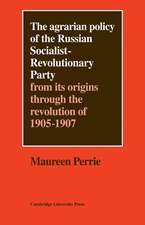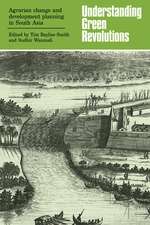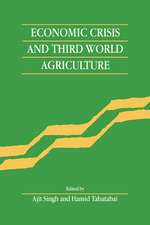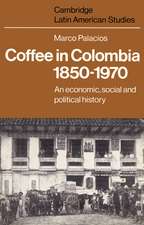Regulation and the Revolution in United States Farm Productivity: Studies in Economic History and Policy: USA in the Twentieth Century
Autor Sally H. Clarkeen Limba Engleză Paperback – 24 iul 2002
| Toate formatele și edițiile | Preț | Express |
|---|---|---|
| Paperback (1) | 271.77 lei 6-8 săpt. | |
| Cambridge University Press – 24 iul 2002 | 271.77 lei 6-8 săpt. | |
| Hardback (1) | 698.61 lei 6-8 săpt. | |
| Cambridge University Press – 24 noi 1994 | 698.61 lei 6-8 săpt. |
Preț: 271.77 lei
Nou
Puncte Express: 408
Preț estimativ în valută:
52.00€ • 54.44$ • 43.03£
52.00€ • 54.44$ • 43.03£
Carte tipărită la comandă
Livrare economică 05-19 aprilie
Preluare comenzi: 021 569.72.76
Specificații
ISBN-13: 9780521528450
ISBN-10: 0521528453
Pagini: 328
Ilustrații: 26 b/w illus. 45 tables
Dimensiuni: 153 x 230 x 23 mm
Greutate: 0.49 kg
Ediția:Revised.
Editura: Cambridge University Press
Colecția Cambridge University Press
Seria Studies in Economic History and Policy: USA in the Twentieth Century
Locul publicării:New York, United States
ISBN-10: 0521528453
Pagini: 328
Ilustrații: 26 b/w illus. 45 tables
Dimensiuni: 153 x 230 x 23 mm
Greutate: 0.49 kg
Ediția:Revised.
Editura: Cambridge University Press
Colecția Cambridge University Press
Seria Studies in Economic History and Policy: USA in the Twentieth Century
Locul publicării:New York, United States
Cuprins
Part I. Regulation and Productivity: 1. Introduction; 2. Agriculture and the organization of knowledge in the early twentieth century; 3. Accounting for the slow rate of productivity growth; Part II. 'Power Farming' in the Corn Belt, 1920–40: 4. The tractor factor; 5. Depressed markets and market regulation; 6. 'If you'll need a tractor in 1936 you ought to order it now'; Part III. A Legacy for New Deal Regulation: 7. Regulation, competition, and the revolution in farm productivity; 8. Conclusion; Epilogue: The credit crisis of the 1980s; Appendix A. The tractor's threshold, 1929; Appendix B. The tractor's threshold, 1939; Appendix C. Sources of preharvest and harvest labor productivity, 1929–39.
Recenzii
"...a fine and provocative study. We can only hope that this book will generate many other works that also seek to challenge prevailing simplistic explanations of change and that build on Clarke's elegant assessment of the emerging issues." Technology and Culture
"This is a model monograph that judiciously employs economic theory and business history to tackle an intriguing question....Clarke's methodology should be extended to other regulated industries, for she has shown that focusing on a broad array of forces (productivity, finance, technology, competition, political action) over time can yield fruitful analyses of ideologically charged subjects." American Historical Review
"Although Clarke is a historian her work provides more than standard historical perspectives, and this book should prove useful and interesting to a wide range of economists....Clarke's book is well researched and thought provoking. Those interested in the economic history of agriculture will find this book interesting and challenging..." Journal of Economic Literature
"This is a theoretically informed and empirically careful and thorough study with important implications for public policy." The Journal of American History
"Clarke brilliantly shows the circumstances and conditions under which business and government could and did work together to further the development of one of the nation's critical industries....America's farmers, politicians, and pundits would reap a huge harvest if they could consult Clarke's insightful book before the nation embarks on a new set of agricultural policies." Business History Review
"By combining economic and business history, Clarke has produced a study with much to say about the economics of twentieth-century agriculture in general and the New Deal period in particular....The book has many strengths. The argument throughout is stated forcefully and with great clarity, and is buttressed by extensive research in the published records and unpublished manuscripts of the USDA, the state experiment stations, and implement companies and farm lenders. It explains in detail the role of credit in midwestern farming, the behavior of agribusiness, and the impact of the New Deal in the Corn Belt--all subjects too often slighted by historians studying agriculture in the 1930s. It also focuses attention on the long-term implications of the farm programs. Finally, its epilogue offers a perceptive appraisal of the causes of the farm credit crisis of the 1980s." David E. Hamilton, Agricultural History
"This is a model monograph that judiciously employs economic theory and business history to tackle an intriguing question....Clarke's methodology should be extended to other regulated industries, for she has shown that focusing on a broad array of forces (productivity, finance, technology, competition, political action) over time can yield fruitful analyses of ideologically charged subjects." American Historical Review
"Although Clarke is a historian her work provides more than standard historical perspectives, and this book should prove useful and interesting to a wide range of economists....Clarke's book is well researched and thought provoking. Those interested in the economic history of agriculture will find this book interesting and challenging..." Journal of Economic Literature
"This is a theoretically informed and empirically careful and thorough study with important implications for public policy." The Journal of American History
"Clarke brilliantly shows the circumstances and conditions under which business and government could and did work together to further the development of one of the nation's critical industries....America's farmers, politicians, and pundits would reap a huge harvest if they could consult Clarke's insightful book before the nation embarks on a new set of agricultural policies." Business History Review
"By combining economic and business history, Clarke has produced a study with much to say about the economics of twentieth-century agriculture in general and the New Deal period in particular....The book has many strengths. The argument throughout is stated forcefully and with great clarity, and is buttressed by extensive research in the published records and unpublished manuscripts of the USDA, the state experiment stations, and implement companies and farm lenders. It explains in detail the role of credit in midwestern farming, the behavior of agribusiness, and the impact of the New Deal in the Corn Belt--all subjects too often slighted by historians studying agriculture in the 1930s. It also focuses attention on the long-term implications of the farm programs. Finally, its epilogue offers a perceptive appraisal of the causes of the farm credit crisis of the 1980s." David E. Hamilton, Agricultural History
Descriere
This book explains how US government activity in the 1930s led to gains in farm productivity.
